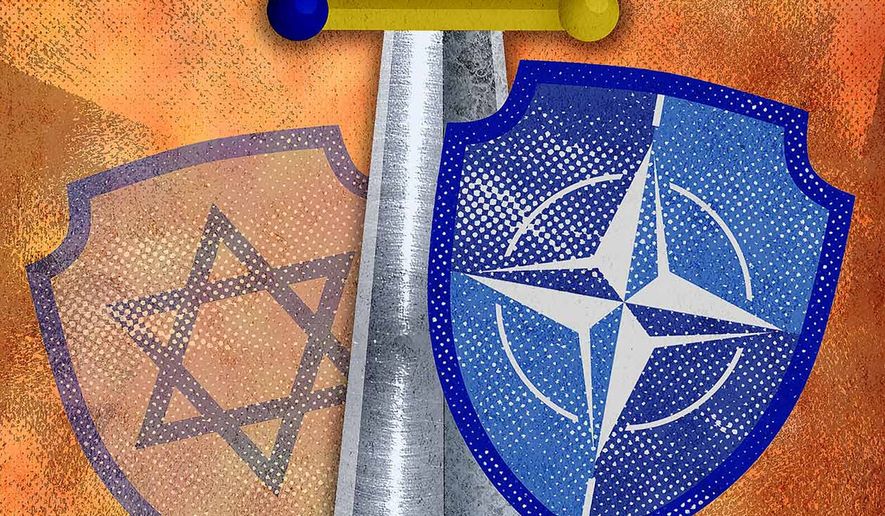OPINION:
A version of this story appeared in the daily Threat Status newsletter from The Washington Times. Click here to receive Threat Status delivered directly to your inbox each weekday.
It has been four months since President Biden unveiled his $105 billion aid package to Ukraine, Israel and Taiwan. Despite an array of concessions made to the Republicans, who argued that the Ukraine aid should be tied to a border security deal and wanted a clearer outline of America’s war strategy, the lengthy brinkmanship is not over.
Nor is there much reason to believe that it will be — even if Congress passes aid this spring — as former President Donald Trump continues his presidential campaign, standing a good chance to secure a second term in the November election.
For Ukraine, which is running short of ammunition and is in dire need of more aid, this presents a lesson outside of the immediate perils of renewed Russian advances recently successful in Avdiivka.
After its failed peace talks with Russia in spring 2022, Ukraine chose to stick to its NATO membership path. Much hope, though, admittedly, unfounded, was placed on last year’s NATO summit in Vilnius, Lithuania, that proved to be neither fish nor fowl. Ukraine did not get the green light to accede to the alliance nor a concrete timeline of the steps needed to do so. Its membership prospect was again reduced to a vague promise.
This prompted Ukraine to consider options outside of NATO, such as the adoption of a security model like that of Israel, a non-NATO state that enjoys close cooperation with the U.S. — though always with considerable caution, as Israel is believed to have a nuclear arsenal, of which Ukraine was deprived in 1994 with the Budapest Memorandum.
There is also the insistence on it by Russia-sympathetic scholars who falsely attribute Moscow’s attack on Ukraine as a response to former Soviet states joining NATO.
Yet it is the aftermath of Hamas’ incursion into Israel last Oct. 7 that turned out to be a revelation. While sending shock waves worldwide, it also laid bare the limits of Washington’s ability to assist in response to multiple conflicts.
Despite U.S. commitments and many Republicans being more favorable toward Israel than Ukraine, the stand-alone package failed to receive sufficient votes in the House. There is also the growing anti-Israeli sentiment in some segments of American society, especially after Israel retaliated in the Gaza Strip, to which the Democrats and Mr. Biden have also been forced to respond. Israeli leaders often find this irritating and unjust.
If Israel, which enjoys close ties with the U.S. and has a powerful lobby, especially among evangelical Christians, fails to secure aid fast, then what can Ukraine, a much newer and younger partner, expect from such a defense model?
Many Ukrainians asked themselves just that. Former Foreign Minister Pavlo Klimkin emphasized several times that he deems Israel’s security model unsuitable for Ukraine — precisely due to the political volatility in the U.S. that, in his words, could be the new norm.
This leaves Kyiv hung up.
For the time being, Ukraine — much like Israel did prior to the 1970s, when it relied on London and Paris — is rightly focusing on the conclusion of ad hoc security guarantees, Britain, France, Germany, Denmark and Italy included.
These measures, however, can be viewed only as an interim step before full-fledged NATO membership. At most, Ukraine can replicate the Israeli security model by nurturing its high-tech sector. The aid that Israel receives from the U.S., including that on a yearly basis, is neither charity nor fully unconditional. It is to be spent within the U.S. military complex while Washington receives access to some Israeli technology.
Ukraine will undoubtedly be unable to achieve an Israel-like technological frontier in the short term due to brain drain and investors hesitating to commit their resources. It would take at least several decades of consistent and hefty spending to turn the tide — even though major defense companies such as Palantir have been reported to aid Ukraine in becoming more technologically advanced.
But for Ukraine to move forward, none of this will suffice in the long term. Nor is it adequate given that Kyiv has begun the European Union accession talks, which will inevitably raise the security matter. Ukraine cannot remain militarily neutral given its geography and history inside the union, which is now almost a NATO-exclusive area.
Russia is already ramping up its propaganda machine, with Tucker Carlson’s interview of dictator Vladimir Putin serving as an example of that, further polarizing societies and sowing distrust — to which politicians will have to respond.
It is also rearming fast, prompting NATO states to come to terms with the prospect of a war between the alliance and Russia in several years, regardless of what happens in Ukraine.
If Mr. Trump is elected president in November — this time, with loyalists by his side only — it could encourage Russia to act further. He has already made it clear that he sees his security relations with the allies through the lens of a “you get what you give” security model.
Though there is little optimism that the upcoming NATO summit in Washington will add clarity to Ukraine’s membership, it is paramount that the notion of having no alternatives to it — in the U.S. foremost — must finally sink in.
The only language Russia understands is that of strength and concrete steps. Let’s communicate with it accordingly.
• Lesia Dubenko is a Ukraine-based international affairs analyst and journalist with a degree in European affairs from Lund University. Her work has appeared in the Financial Times, Politico Europe, Atlantic Council, New Eastern Europe and the Kyiv Post.




Please read our comment policy before commenting.